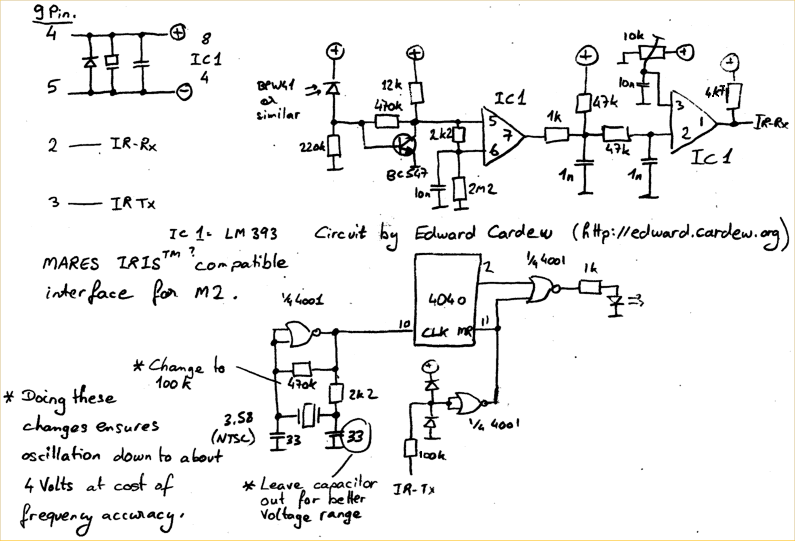
MARES IRIS Interface schematic circuit

A TSOP4156 is often difficult to obtain or expensive to purchase. In response, an individual utilized old BPW41 infrared diodes to construct a custom receiver. The power source is derived from the RS232 port, requiring a minimum of 5.5 volts; otherwise, the 4001 will not oscillate effectively at 3.6 MHz. It may be possible to operate at 5 volts by adjusting certain components. The laptop in use can supply 5.5 volts, which is adequate. The logic chips employed are standard CMOS, eliminating the need for voltage regulation, thus saving costs. Additionally, the RESET circuit of the 4040 was deemed excessive, and modifications were made to conserve a NOR circuit. The circuit design represents a minimalistic approach when a TSOP is not desired. The circuit can be optimized for lower voltages by replacing the 470k resistor with a 100k resistor and removing the 33pF capacitor connected to the 2.2k resistor in the oscillator. This modification allows oscillation down to 4 volts, although the frequency may not be precise, which is not critical. A 10k trimmer is used to adjust for 28% of the supply voltage to achieve optimal receive bit timing. The final prototype is compact enough to fit within a mouse. Software for the project is available on the MARES website. For those who own an M2 RGBM, it is suggested to simulate an M1 for the purpose of downloading dive logs.
The circuit described utilizes a BPW41 infrared diode as the primary light sensor, which is capable of detecting modulated infrared signals. The receiver is powered through the RS232 port, which typically provides a voltage range sufficient for the operation of the circuit. The choice of CMOS logic chips is advantageous due to their low power consumption and ability to function effectively without the need for additional voltage regulation.
The oscillator circuit, which includes the 4001 IC, is essential for generating the necessary frequency for signal processing. The adjustment of the resistor values and the capacitor is crucial for optimizing performance, particularly when operating at lower voltages. The use of a 10k trimmer allows for fine-tuning of the output to ensure that the receiver can accurately interpret incoming data signals.
The design’s compactness is a significant advantage, as it allows for integration into small enclosures, such as a computer mouse. This aspect of the project highlights the versatility and practicality of DIY electronics in creating functional devices from readily available components. The software available on the MARES website provides the necessary tools for programming and operating the receiver, facilitating its use in various applications, including data logging for dive computers. This approach exemplifies how innovative solutions can be developed through the repurposing of existing technologies.You need a TSOP4156 which can be a tough one to get or expensive to buy. I had plenty of old BPW41 Infrared diodes so I decided to build my own receiver. The power comes from the RS232 port, make sure you have at least 5. 5 Volts or the 4001 will not oscillate well at 3. 6 MHz (Maybe you can get it to work at 5 Volts by adjusting some components. My Laptop can just manage 5. 5 Volts so I was OK. The logic chips are good old CMOS so no need to regulate to 5 Volts, more money saved. Also I found the RESET circuit of the 4040 "over the top", changing this saves yet one more NOR circuit. This circuit is realy the bare minimum in my opinion when you do not want the TSOP. The above circuit can be optimized for low voltages by changing the 470k resistor to 100k and removing the right 33pF capacitor connected to the 2k2 resistor in the oscillator (which is what I have done).
Now it oscillates down to 4 Volts but the frequency is not quite right, which is not important. Adjust the 10K trimmer for 28% of the supply voltage to obtain optimal receive bit timing. My final prototype fits in a mouse. The Software can be found on the MARES website. If like me you are a happy owner of an M2 RGBM then just pretend you have an M1 and happy dive log downloading! 🔗 External reference
The circuit described utilizes a BPW41 infrared diode as the primary light sensor, which is capable of detecting modulated infrared signals. The receiver is powered through the RS232 port, which typically provides a voltage range sufficient for the operation of the circuit. The choice of CMOS logic chips is advantageous due to their low power consumption and ability to function effectively without the need for additional voltage regulation.
The oscillator circuit, which includes the 4001 IC, is essential for generating the necessary frequency for signal processing. The adjustment of the resistor values and the capacitor is crucial for optimizing performance, particularly when operating at lower voltages. The use of a 10k trimmer allows for fine-tuning of the output to ensure that the receiver can accurately interpret incoming data signals.
The design’s compactness is a significant advantage, as it allows for integration into small enclosures, such as a computer mouse. This aspect of the project highlights the versatility and practicality of DIY electronics in creating functional devices from readily available components. The software available on the MARES website provides the necessary tools for programming and operating the receiver, facilitating its use in various applications, including data logging for dive computers. This approach exemplifies how innovative solutions can be developed through the repurposing of existing technologies.You need a TSOP4156 which can be a tough one to get or expensive to buy. I had plenty of old BPW41 Infrared diodes so I decided to build my own receiver. The power comes from the RS232 port, make sure you have at least 5. 5 Volts or the 4001 will not oscillate well at 3. 6 MHz (Maybe you can get it to work at 5 Volts by adjusting some components. My Laptop can just manage 5. 5 Volts so I was OK. The logic chips are good old CMOS so no need to regulate to 5 Volts, more money saved. Also I found the RESET circuit of the 4040 "over the top", changing this saves yet one more NOR circuit. This circuit is realy the bare minimum in my opinion when you do not want the TSOP. The above circuit can be optimized for low voltages by changing the 470k resistor to 100k and removing the right 33pF capacitor connected to the 2k2 resistor in the oscillator (which is what I have done).
Now it oscillates down to 4 Volts but the frequency is not quite right, which is not important. Adjust the 10K trimmer for 28% of the supply voltage to obtain optimal receive bit timing. My final prototype fits in a mouse. The Software can be found on the MARES website. If like me you are a happy owner of an M2 RGBM then just pretend you have an M1 and happy dive log downloading! 🔗 External reference





